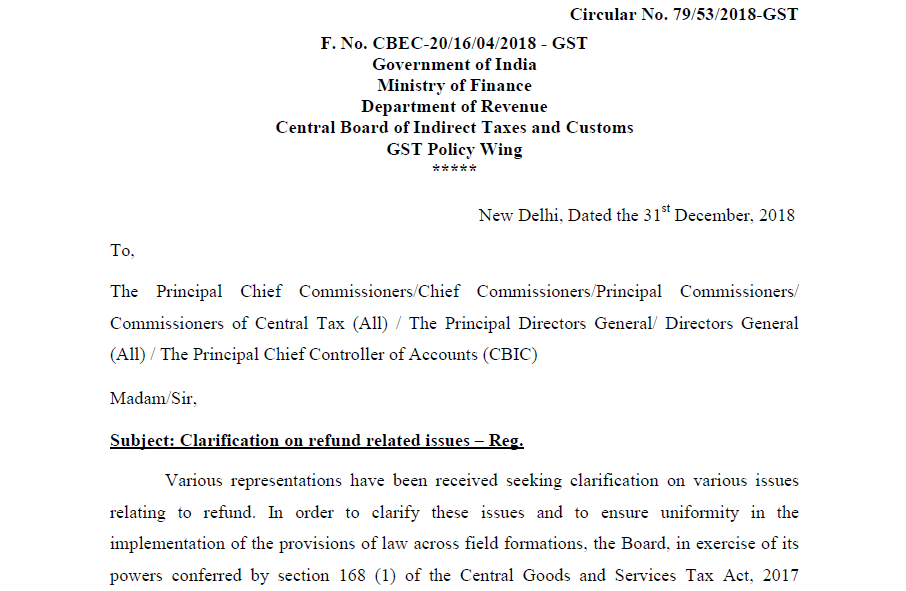Circular No. 79/53/2018-GST
Circular No. 79/53/2018-GST
Circular No. 79/53/2018-GST
F. No. CBEC-20/16/04/2018 – GST
Government of India
Ministry of Finance
Department of Revenue
Central Board of Indirect Taxes and Customs
GST Policy Wing
New Delhi, Dated the 31st December 2018
To,
The Principal Chief Commissioners/Chief Commissioners/Principal Commissioners/ Commissioners of Central Tax (All) / The Principal Directors General/ Directors General (All) / The Principal Chief Controller of Accounts (CBIC)
Madam/Sir,
Subject: Clarification on refund related issues – Reg.
Various representations have been received seeking clarification on various issues relating to refund. In order to clarify these issues and to ensure uniformity in the implementation of the provisions of law across field formations, the Board, in exercise of its powers conferred by section 168 (1) of the Central Goods and Services Tax Act, 2017 (hereinafter referred to as “CGST Act”), hereby clarifies the issues detailed hereunder:
Physical submission of refund claims with the jurisdictional proper officer:
2. Due to the non-availability of the complete electronic refund module, a workaround was prescribed vide Circular No. 17/17/2017-GST dated 15.11.2017 and Circular No. 24/24/2017-GST dated 21.12.2017, wherein a taxpayer was required to file FORM GST RFD-01A on the common portal, generate the Application Reference Number (ARN), take print-outs of the same, and submit it physically in the office of the jurisdictional proper officer, along with all the supporting documents. It has been learned that this requirement of physical submission of documents in the jurisdictional tax office is causing undue hardship to the taxpayers. Therefore, in order to further simplify the refund process, the following instructions, in partial modification of the aforesaid circulars, are issued:
a) All documents/undertaking/statements to be submitted along with the claim for refund in FORM GST RFD-01A shall be uploaded on the common portal at the time of filing of the refund application. Circular No. 59/33/2018-GST dated 04.09.2018 specified that instead of providing copies of all invoices, a statement of invoices needs to be submitted in a prescribed format and copies of only those invoices need to be submitted the details of which are not found in FORM GSTR-2A for the relevant period. It is now clarified that the said statement and these invoices, instead of being submitted physically, shall be electronically uploaded on the common portal at the time of filing the claim of refund in FORM GST RFD-01A. Neither the application in FORM GST RFD-01A, nor any of the supporting documents, shall be required to be submitted physically in the office of the jurisdictional proper officer.
Related Topic:
Circular No. 59/33/2018-GST
b) However, the taxpayer will still have the option to physically submit the refund application to the jurisdictional proper officer in FORM GST RFD-01A, along with supporting documents, if he so chooses. A taxpayer who still remains unallocated to the Central or State Tax Authority will necessarily have to submit the refund application physically. They can choose to do so before the jurisdictional proper officer of either the State or the Central tax authority, as was earlier clarified vide Circular No. 17/17/2017 – GST dated 15.11.2017.
c) The ARN will be generated only after the claimant has completed the process of filing the refund application in FORM GST RFD-01A, and has completed uploading of all the supporting documents/undertaking/statements/invoices and, where required, the amount has been debited from the electronic credit/cash ledger.
d) As soon as the ARN is generated, the refund application along with all the supporting documents shall be transferred electronically to the jurisdictional proper officer who shall be able to view it on the system. The application shall be deemed to have been filed under rule 90(2) of the Central Goods and Services Tax Rules, 2017 (hereinafter referred to as “CGST Rules”) on the date of generation of the said ARN and the time limit of 15 days to issue an acknowledgment shall be counted from that date. This will obviate the need for a claimant to visit the jurisdictional tax office for the submission of the refund application. Accordingly, the acknowledgment for the complete application or deficiency memo, as the case may be, would be issued by the jurisdictional tax officer based on the documents so received electronically from the common portal. However, the said acknowledgment or deficiency memo shall continue to be issued manually for the time being.
e) If a refund application is electronically transferred to the wrong jurisdictional officer, he/she shall reassign it to the correct jurisdictional officer electronically within a period of three days. In such cases, the application shall be deemed to have been filed under rule 90(2) of the CGST Rules only after it has been so reassigned. Deficiency memos shall not be issued in such cases merely on the ground that the applications were received electronically in the wrong jurisdiction. Where the facility of electronic re-assignment is not available, the present arrangement shall continue.
f) It has already been clarified vide Circular No. 70/44/2018-GST dated 26.10.2018 that after the issuance of a deficiency memo, taxpayers would be required to submit the rectified refund application under the earlier Application Reference Number (ARN) only. It is further clarified that the rectified application, which is to be treated as a fresh refund application, will be submitted manually in the office of the jurisdictional proper officer.
3. It may be noted that the documents/statements/undertakings/invoices to be submitted along with the refund application in FORM GST RFD-01A are the same as have been prescribed under the CGST Rules and various Circulars issued on the subject from time to time. Only the method of submission of these documents/statements/undertakings/invoices is being changed from the physical mode to the electronic mode. It may also be noted that the other stages of processing of a refund claim submitted in FORM GST RFD-01A by the jurisdictional tax officer shall continue to be carried out manually for the time being, as is being presently done.
Download the full Circular No. 79/53/2018-GST, by clicking the below image:
Calculation of refund amount for claims of refund of accumulated Input Tax Credit (ITC) on account of inverted duty structure:
4. Representations have been received stating that while processing the refund of unutilized ITC on account of inverted tax structure, the departmental officers are denying the refund of ITC of GST paid on those inputs which are procured at equal or lower rate of GST than the rate of GST on outward supply, by not including the amount of such ITC while calculating the maximum refund amount as specified in rule 89(5) of the CGST Rules. The matter has been examined and the following issues are clarified:
a) Refund of unutilized ITC in case of inverted tax structure, as provided in section 54(3) of the CGST Act, is available where ITC remains unutilized even after setting off of available ITC for the payment of output tax liability. Where there are multiple inputs attracting different rates of tax, in the formula provided in rule 89(5) of the CGST Rules, the term „Net ITC‟ covers the ITC availed on all inputs in the relevant period, irrespective of their rate of tax.
b) The calculation of refund of accumulated ITC on account of inverted tax structure, in cases where several inputs are used in supplying the final product/output, can be clearly understood with help of the following example:
i. Suppose a manufacturing process involves the use of an input A (attracting 5 per cent GST) and input B (attracting 18 per cent GST) to manufacture output Y (attracting 12 per cent GST).
ii. The refund of accumulated ITC in the situation at (i) above, will be available under section 54(3) of the CGST Act read with rule 89(5) of the CGST Rules, which prescribes the formula for the maximum refund amount permissible in such situations.
iii. Further assume that the claimant supplies the output Y having value of Rs. 3,000/- during the relevant period for which the refund is being claimed. Therefore, the turnover of inverted rated supply of goods and services will be Rs. 3,000/-. Since the claimant has no other outward supplies, his adjusted total turnover will also be Rs. 3,000/-.
iv. If we assume that Input A, having value of Rs. 500/- and Input B, having value of Rs. 2,000/-, have been purchased in the relevant period for the manufacture of Y, then Net ITC shall be equal to Rs. 385/- (Rs. 25/- and Rs. 360/- on Input A and Input B respectively).
v. Therefore, multiplying Net ITC by the ratio of turnover of inverted rated supply of goods and services to the adjusted total turnover will give the figure of Rs. 385/-.
vi. From this, if we deduct the tax payable on such inverted rated supply of goods or services, which is Rs. 360/-, we get the maximum refund amount, as per rule 89(5) of the CGST Rules which is Rs. 25/-.
 ConsultEase Administrator
ConsultEase Administrator
Consultant
Faridabad, India
As a Consultease Administrator, I'm responsible for the smooth administration of our portal. Reach out to me in case you need help.









